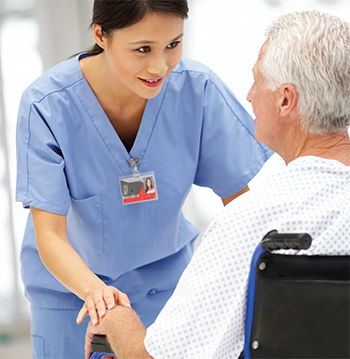You may have noticed a new addition to Safe Patient Handling. ANA’s 2013 Safe Patient Handling and Mobility: Interprofessional National Standards updated the 1980s terminology of “Safe Patient Handling” and “Safe Patient Handling and Movement.”
The change is an important one. Adding “and mobility” recognizes that safe patient handling is more than simply the passive handling, transfer, and movement of healthcare recipients. Rather, “mobility” implies active involvement of the healthcare recipient and healthcare worker in progressing activity and mobility level to improve health and safety outcomes.
ANA partnered with The Association of Safe Patient Handling Professionals to develop a white paper to explain this important change in terminology. Advancing the Science and Technology of Progressive Mobility includes case studies to provide evidence that early and progressive mobility, using safe patient handling and mobility (SPHM) technology, serves to improve healthcare recipient outcomes. The authors emphasize the shared goals of nurses and physical therapists to promote mobility using SPHM technology. Below is a case study featured in the white paper:
| Case study 1: Example of early mobility therapy and positive patient outcomes:Case Description: The patient was a 42-year-old male, 6’5” and 300 lbs., diagnosed with West Nile Virus and hospitalized at a Midwest Level 1 trauma center for three weeks. During his stay, he sat on the edge of the bed a few times unsupported, but only for a few minutes. Following initial care, he was transferred to another Midwest facility for his inpatient rehabilitation therapy, where he stayed for an additional three weeks. At this point the patient had not stood since his hospital admission; before admission he was independent in all mobility aspects and wanted to return to his prior level of function as soon as possible.Outcome: The care staff used mobile (floor) lift equipment early for transfers from bed to chair. Because of the patient’s size and weakness, the physical therapists used the lift and lifting pants to help him safely stand in the parallel bars. The care team was able to stand the patient at the bedside using the lift pants before attempting to ambulate him with the use of the walker. Even as he got stronger toward the end of his stay, the team used the lift pants with ambulation because he was still very shaky and his size would put patient and staff at risk for injury without the SPHM technology. The lift pants were also used with the patient for the first weeks when trailing stairs and for gait on the treadmill. SPHM technology was used every day for the first 75% of the rehab stay, initially to help lift him and then to serve as a safety net for the patient and staff as a modality to challenge his strength and balance without compromising safety. The patient returned home after approximately six weeks of being hospitalized, and with the help of his wife, he has returned to his normal activities of daily living. |
This example illustrates the benefits of early and progressive mobility. Early mobility involves the practice of passive and active range of motion, as well as the use of SPHM technology to ambulate healthcare recipients sooner and safer. Progressive mobility is a stepped approach that allows the healthcare recipient to regain baseline mobility function while in the early phase of hospitalization and treatment.
When early and progressive mobility treatment plans are coupled with SPHM technology, care is safer and more efficient than ever before. So the next time you use the term “Safe Patient Handling” try not to forget “and Mobility.” The language represents an important shift toward both promoting safety and improving quality health outcomes.
The white paper Advancing the Science and Technology of Progressive Mobility is available for free download at www.nursingworld.org.
The Safe Patient Handling and Mobility: Interprofessional National Standards and the Implementation Guide to the Safe Patient Handling and Mobility Interprofessional National Standards can be purchased at www.nursesbooks.org.
Jaime Murphy Dawson is a senior policy analyst in the Department of Nursing Practice and Work Environment at ANA.



















1 Comment.
This sounds terrific and is definitely the way to go. However, the equipment needed is not readily available or inexpensive I’m sure. The words are great, but until 90% or more of facilities can put it to practise it’s only a dream.